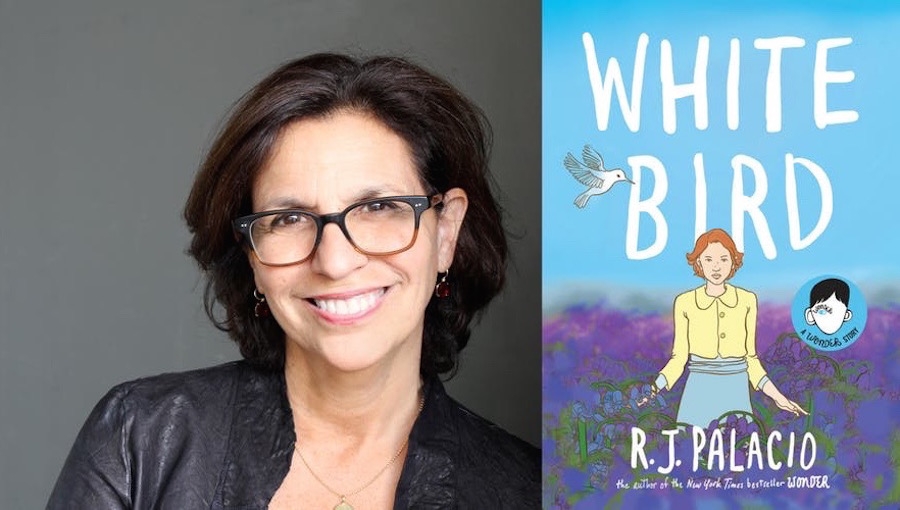The following is an interview with R. J. Palacio, writer and illustrator of the upcoming graphic novel, White Bird. In this interview, Fanbase Press Editor-in-Chief Barbra Dillon chats with Palacio about the inspiration behind the graphic novel, her creative process in balancing both the writing and illustrative duties, what she hopes that readers will take away from the book, and more!
Barbra Dillon, Fanbase Press Editor-in-Chief: Congratulations on the upcoming release of your graphic novel, White Bird, through Alfred A. Knopf Books for Young Readers! In light of your previous work on the novels Wonder and Auggie & Me, what inspired you to bring this story to the sequential-art medium?
R. J. Palacio: Thank you! The story about Grandmère—and the hardships she endured as a young Jewish girl forced into hiding in Nazi-occupied France—had been percolating in my mind for several years, ever since I first introduced the bare outlines of her story in The Julian Chapter. But the way her story was unfolding in my head felt especially cinematic, even more than usual for me. I mean, my writing always tends to be pretty visual, using words to represent images in my head (i.e., the image of a boy in an astronaut helmet became the emblem of Wonder; a skyline of NYC water towers turning into rocket ships became a pivotal scene in We’re All Wonders). But White Bird seemed even more image-oriented to me, so when I started working on it, sketching the scenes came very naturally to me. It was like I was bringing to life a dream inside my head.
BD: Given that this is your debut as both writer and illustrator of a graphic novel, what can you share with readers about your experience in balancing both the writing and illustrative duties of the project? Likewise, what were your creative influences in bringing the story to life?
RJP: It may seem strange to say, but there was really no balancing that I had to do, since the words and the pictures came at the same time. I would write a scene, and then sketch it out. Or I would draw an image, and then write it. They happened simultaneously. Having the capacity to actually draw the scenes was very liberating, because I didn’t have to spend too much time describing things, or getting characters from one place to another.
In terms of creative influences, I’ve been a fan of comic books and graphic novels since I was thirteen years old and discovered my older brother’s stash of Marvel comics when he went away to college. The comic in which Spider-Man was first introduced. The origin of Daredevil. The Avengers. The Fantastic Four. I’m not saying those directly influenced White Bird, of course, but they had an impact on me as an artist and storyteller. In terms of technical help pulling this graphic novel together, since I didn’t have direct experience in actually drawing and writing one myself, I have to credit Mark Siegel, who is a friend of mine, for giving me invaluable feedback along the way. And, of course, I couldn’t have done it without Kevin Czap, who took my sketches and inked them to perfection.
BD: Next month, you will be appearing at New York Comic Con and meeting fans on an extensive book tour. What are you most looking forward to with regard to meeting fans and hearing the direct impact of your work?
RJP: This may be my first public appearance at a Comic Con convention as an author, but it won’t be the first time I’ve gone to one, by any means. Remember, Wonder was full of Star Wars, LOTR, and superhero references—and that was because I’m a huge SF and fantasy fan! Not only did I take my sons to Comic Con when they were younger, but I used to go to SF conventions when I was a teenager. There’s nothing like a Comic Con fan, and I’m really looking forward to meeting them.
BD: What makes Alfred A. Knopf Books for Young Readers the perfect home for White Bird?
RJP: The most wonderful thing about Knopf is that they are so willing to take risks. For instance, they took a risk on Wonder at a time when everyone was publishing dystopian fiction. A quiet book about a kid with a facial difference, in which nothing magical happens to transform him (except for the power of kindness) was, back in 2010/2011, kind of revolutionary. Similarly, when I said I wanted to publish White Bird in hardcover, with a special binding that actually hasn’t been done before, they were willing to take the risk. I have an editor who is always open to trying new things, whether it’s a picture book (though I’d never done that before), or a book of precepts, or now a graphic novel. Knopf doesn’t try to corral me, and I appreciate that greatly.
BD: Are you working on any upcoming projects that you would like to share with our readers?
RJP: Right now I’m concentrating on White Bird, in terms of promoting it, visiting schools, talking about the themes behind the book, and spreading the word about why a story about historical anti-Semitism is so important today. I’ve also become very involved politically to try to combat intolerance and hate rhetoric in the age of Trumpism.
BD: Lastly, what is the best way for our readers to find more information about White Bird and your other work?
RJP: Everything is Googleable these days, but they can log on to my website, wonderthebook.com, to learn more.

